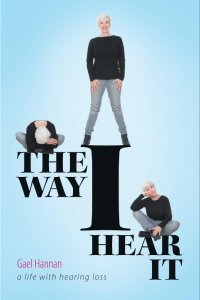Book Review
The Way I Hear It by Gael Hannan
 Let me start with a disclaimer: this review is incredibly biased. I am a huge fan of Gael and of the generous way that she shares the personal side of living with a hearing loss. I first witnessed this at the Canadian Hearing Society in Toronto, where Gael performed her one-woman show for my “Hearing Help” classes, leading the group through laughter to tears and back again – not through emotional manipulation, but through brutal honesty. Her book uses the same generously personal perspective as the basis for an excellent guide to life with hearing loss, as she shares her experiences and strategies that she has developed. Reading this book is like taking a walk with Gael – a funny, touching and educational walk. I’m confident that you will share my bias (if you don’t already) after the walk.
Let me start with a disclaimer: this review is incredibly biased. I am a huge fan of Gael and of the generous way that she shares the personal side of living with a hearing loss. I first witnessed this at the Canadian Hearing Society in Toronto, where Gael performed her one-woman show for my “Hearing Help” classes, leading the group through laughter to tears and back again – not through emotional manipulation, but through brutal honesty. Her book uses the same generously personal perspective as the basis for an excellent guide to life with hearing loss, as she shares her experiences and strategies that she has developed. Reading this book is like taking a walk with Gael – a funny, touching and educational walk. I’m confident that you will share my bias (if you don’t already) after the walk.
The book is divided into seven major sections that cover different aspects of life with hearing loss, woven together with charming anecdotes and poetry. In doing so it transforms helpful-but-dry information (e.g., it takes time to get used to new hearing aids, bluffing is a counterproductive strategy) into an easy-to-digest and entertaining form that is more likely to be read, more meaningful and more likely to be remembered. It also takes us to places that we may have never thought to go, but we’ll talk more about that in a moment.
The first section dives headfirst into issues of identity and acceptance. As every clinician knows, hearing loss is not just a line on an audiogram; it is a part of someone’s life. We play a role in helping people who are dealing with these issues, so it is just as important that we develop an understanding of the process as it is for the people we serve. Gael discusses her own acceptance and identity struggles and then presents a helpful overview of the seven phases through which someone with hearing loss will move in the journey from Internal Debate (“Do I have a hearing loss and should I do something about it?”) to Learning to Live with Hearing Loss. The section even touches on the tricky issues about what to call someone with hearing loss, in Gael’s signature style:
By identifying as hard of hearing, I am connected to a national and international community, but damn, I still hate the term…
I could try compacting it into an acronym. Hard of Hearing = HoH, which looks nice on paper, but has a different meaning when spoken out loud:
“Hi there, I’m a HoH.”
 The second section covers the familiar territory of communication strategies, including a wonderful set of tips for talking to someone with hearing loss, along with the importance of each tip, and how to make the request if you are the one with the hearing loss. She then shares her own experiences with speechreading and signing, both as a student and a teacher in the case of speechreading. The final part of this section discusses the somewhat awkward issue of bluffing, which she calls “The Dark Force.” My favourite part is her argument as to why the Mona Lisa is obviously a portrait of a girl with hearing loss caught bluffing. I won’t spoil this – you’ll have to read it yourself – but I’ll never look at the painting the same way again.
The second section covers the familiar territory of communication strategies, including a wonderful set of tips for talking to someone with hearing loss, along with the importance of each tip, and how to make the request if you are the one with the hearing loss. She then shares her own experiences with speechreading and signing, both as a student and a teacher in the case of speechreading. The final part of this section discusses the somewhat awkward issue of bluffing, which she calls “The Dark Force.” My favourite part is her argument as to why the Mona Lisa is obviously a portrait of a girl with hearing loss caught bluffing. I won’t spoil this – you’ll have to read it yourself – but I’ll never look at the painting the same way again.
The third section covers technology, from hearing aids to batteries, telecoils and even a bit on cochlear implants. This should be required reading for every new hearing aid wearer. It has useful information about maintaining a hearing aid, troubleshooting, and an extended section on battery use and care. It even has a question and answer about how long hearing aids will last (e.g., “Q: Will baking my hearing aids in a pie at 350 degrees for one hour cause permanent damage? A: Yes”). The issue of hearing aid costs is addressed in thoughtful way that considers the value and importance of hearing aids.
In the fourth section the book moves on to issues about relationships, where Gael opens up about the impact of hearing loss on her relationships with her husband and son. The section includes a transcript of a panel discussion in which three couples discussed the impact of hearing loss on their marriage, which is both fascinating and illuminating. There is a wonderful section on the challenge of being a parent with a hearing loss that discusses anxiety and failures as well as strategies for success. She talks about how to explain hearing loss to your child, and even includes a section written by her son.
The fifth section takes the reader to places that are rarely ever considered in discussions about hearing loss, as alluded to earlier. This is the section that asks fantastic questions like “What is plane travel like with a hearing loss? What about checking into hotels? Dining out? Cooking? Music? Physical activity? Experiencing Nature? Being in a stage production?” The sheer breadth of topics and the gentle humour with which each is covered make this a very special book. For those of us on the clinical side, it’s a great reminder that hearing loss intersects with all areas of life and that a hearing aid is just one small component of many problems that will need to be solved by the individual. Gael’s book doesn’t and can’t have the answer to all of life’s problems, but it does show an excellent model for approaching and handling challenging situations.
The sixth section “Waiting for Our Name to be Called” talks about stresses and fears, with a focus on some of the most stressful situations to experience with a hearing loss: waiting for your name to be called in reception areas, interacting with the health care system in general, and handling hearing loss in employment settings. The humour shines through particularly well here, making an emotionally charged topic much less painful to read. Her writing here reminds me of the hilarious David Sedaris. Two of my favourite examples are her description of her MRI scan experience (which I won’t spoil here) and her description of her tinnitus:
Once upon a time my only tinnitus was the pedicure sound of toenail-clipping. Now, I’ve got an orchestra. My favourite is the gong, but it’s also the most infrequent. The loveliest head-sound, waves crashing on the beach, is the most common and therefore the most irritating.
The seventh section, “A HoH’s Best Friends,” discusses support groups and hearing health care professionals, both audiologists and hearing instrument specialists. This should be required reading for all of us. The section finishes by discussing her relationship with her audiologist, her experiences with audiology in general (which have been both positive and negative) and a lovely subsection entitled “Tips for Training the One You’ve Got.” If we all read her book, we can get a head start on the training!
If you only read one book this year, this should be it. In fact, this would be an excellent book to have in your waiting room, or to pass along to people buying hearing aids.

